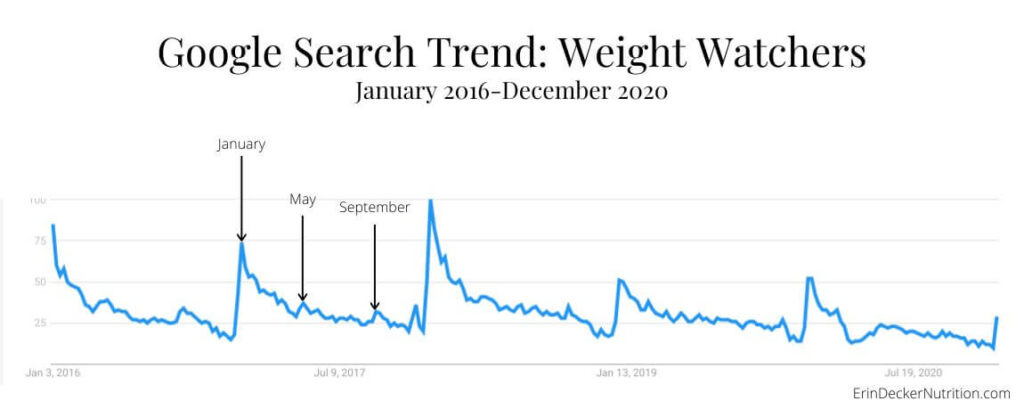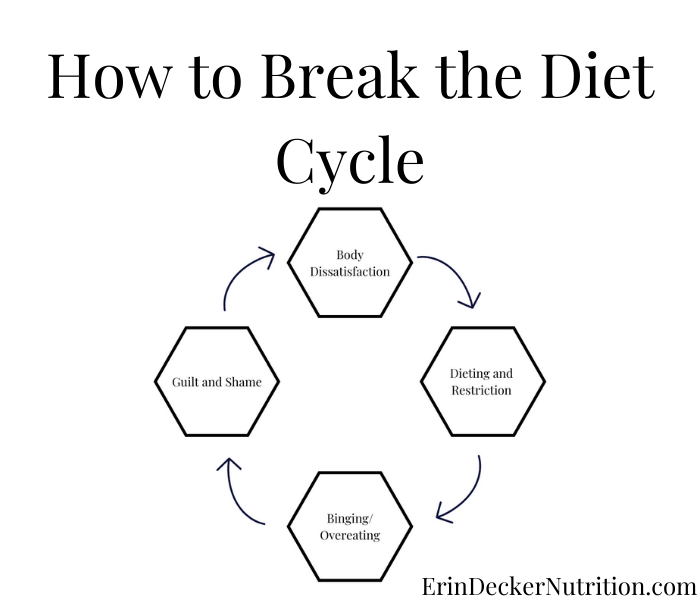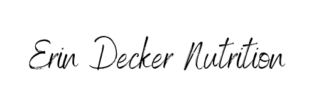January, late spring, and September. That’s when search volume for “weight watchers” spikes on Google.
But if Weight Watchers worked, why do we keep seeing the same spike, season after season, year after year?
I don’t mean to pick on Weight Watchers because there are many other diet programs out there. It just happens to be a perfect analogy for what we call the diet cycle.

The diet cycle keeps you stuck in a trap of worrying about food and your body, followed by strict dieting and restriction, and finally giving up and bingeing on “forbidden” foods, only to start the cycle over the following week.
This article will provide some background and outline how to break the diet cycle.
Table of Contents
What is the diet cycle?
The diet cycle, also known as the binge-restrict cycle, is what results when you go on a diet.
It is a vicious trap that we fall in. It often starts with body dissatisfaction which leads to strict dieting and restriction.
As the diet goes on, normal hormonal changes take place which increase hunger and cravings.
This may be sustainable for a period of time, especially if you are seeing the results that you want to see! However, they are often short-lived because as you know: life happens. You go on vacation, work gets busy, kids go to summer camp, and so on.
Day-to-day stressors increase tension. This tension, coupled with all-or-nothing thinking (e.g. “I’ll just start again in the fall”) leads to overeating and bingeing on “forbidden” foods.
At this point, guilt and shame take over and body dissatisfaction returns, and the cycle is at risk for restarting.

What causes the diet cycle?
The diet cycle is often triggered by body dissatisfaction.
While dieting can start at any time, I have noticed the following prime times for falling prey to the diet cycle: in the New Year, in the spring as you prepare for summer, back-to-school season, and in preparation for a big event or day, such as a wedding.
New year
Coming up on the new year is one of the most popular times to start a new diet.
You are coming off of the holidays where you have indulged in foods and treats that aren’t around at other times of the year. Gym memberships and exercise equipment are on sale. There are messages everywhere telling you that you need to be better than you were last year.
Spring
As the weather warms up, many people are concerned about how their body will look coming into summer. As a result, spring time can be a trigger for starting a new diet.
Back to school
Motivation returns during “back to school” season. For many families, this offers not just a return to school, but a return to a “normal” routine. There tends to be more structure involved in the fall than there is over summer.
Upcoming Event
Weddings, reunions, and vacations are all big triggers for starting a diet. In most cases you will be around other people, possibly people you haven’t seen in a long time. Everyone wants to look their best (nevermind the pressure on brides on their wedding day!)
Recent events and/or a bad day
Sometimes there is no obvious reason for wanting to start a new diet. You may have had a bad day or something put you in a bad mood. In these cases, it is easy to automatically find something wrong with your body.
This is known as mis-attribution. In essence, you mis-attribute your negative feelings to be a result of your body.
Think about the last time you had a “bad body image day” or had the urge to start a diet. What else was going on that day? Were there other stressors or things out of your control?
All of these can mis-represent themselves as a problem with our bodies. Our bodies are a convenient scapegoat for these feelings because they offer a perceived “problem to be fixed”.
What are the risks of the diet cycle?
The diet cycle does not provide any lasting solutions.
It can lead to a disordered relationship with food at best, and an eating disorder at worst. It can contribute to anxiety and depression. Not to mention, it’s just a miserable way to live!
Physiologically, the diet cycle can lead to another phenomenon known as weight cycling. Weight cycling is the process of losing weight and then regaining it, oftentimes regaining more weight than was originally lost in the beginning.
Weight cycling is associated with an increased risk of chronic disease.
Action steps to break the diet cycle
I believe we can break the diet cycle at ANY point. There is no right place to start. However, I believe it will be easier if we start off with a well-nourished mind. We start here by giving up the diet!
Give up the Diet
In order to truly break the diet cycle, it requires first and foremost: give up the diet!
Why is this so important? If you are in a restrictive state, the drive to eat is going to be there, no matter how much willpower you have. It’s a lot harder to make mindful eating decisions when you are hungry!
Practice Self-Compassion
After giving in to forbidden foods, rather than falling into guilt and shame, practice self-compassion and see if you can get curious about this behavior.
Ask yourself: what was the trigger? Was I stressed, hungry, overwhelmed, or did I need a break? See if you can identify patterns here. Apps such as Rise Up and Recover are great for keeping track of these patterns.
Redefine what health means
Our culture places significant moral value on taking care of our health. Dieting and health often go hand in hand in our medical community.
But as discussed, diet and weight cycling may do more harm than good when it comes to your health.
Studies have shown that intuitive eating and weight neutral approaches to care demonstrate similar outcomes as those receiving standard diet advice.
This means that following an intuitive eating approach will allow you to achieve all of the benefits of the “standard diet and lifestyle change” without the risk of weight cycling and disordered eating.
Make Peace with your Body
I get it – we live in a culture that makes it incredibly difficult to develop a positive body image.
But making peace with your natural body size is only going to help you break the diet cycle.
See below for some tips to improve body image:
- Surround yourself with a variety of body types and sizes. Does your social media page need a refresh?
- Think about what your body can DO rather than what it looks like.
- When trying on new clothes, consider how they feel to you before you look in the mirror.
- Reflect on your “good body image and “bad body image” days. What is the difference here? Chances are your body did not change!
- Question the thoughts in your head telling you that your body is not right or that there is something wrong with it. According to whom?
What could you achieve if you stopped spending so much time thinking about food and your body? Join my newsletter for more tips on intuitive eating and non-diet living.

Whether you’re fulfilling a New Years resolution or getting trim for the summer months, there are many reasons why one may wish to drop weight. This is good insight to help people learn how to break the diet cycle.